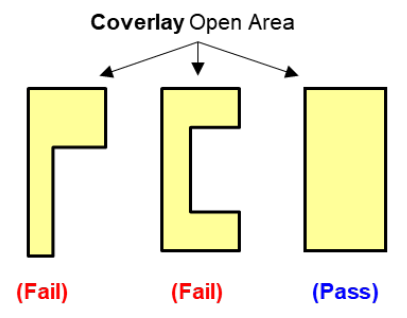Coverlay Open Area
Check rules for Coverlay.

Figure 1.
- Target Layer Definition: Define target layer for checking.
- Layer Definition for Check Area: Select target layer from layer list.
- Coverlay Layer Definition: Define Coverlay layer for checking.
- Coverlay Data Type: Select Coverlay layer data type between Positive and Negative.
- Top/Bottom: Select Coverlay top and bottom layer from layer list.
- FPCB Layer Definition: If PCB is a mixed design, as in FPCB (Flexible PCB)
and Rigid PCB together, it is able to check the clearance with a certain
value for FPCB. In this case, you can define the FPCB layer for checking.
- Layer Name or Layer Comment: Can define the FPCB layer information by layer name or comment of layer.
- FPCB Layer Filter: Set the layer information.
- Checking: Check Coverlay opened for patterns and vias.

Figure 2.- For coverlay opening, check Pattern existence: Check pattern
Coverlay opening.
- Exclude Checking for Coverlay Opened for Both Sides: If pattern Coverlay data are open in the top and bottom, PollEx DFM will not check for this pattern.
- For coverlay opening, check Via existence: Check via Coverlay opening.
- Exclude Checking for Nets: Exclude vias connected to certain nets. To do this, select nets from netlist.
- In Case of Via on Pad, Check Coverlay on the Other Side of Component
Placement: If a via is placed on pad, check the other side to see if
there is a Coverlay or not. If there is no Coverlay on the other
side, it is a fail.

Figure 3.- Except for Selected Via Hole Size: For certain size of via holes, exclude checking for them.
- Checking if the coverlay open area is rectangle shape: Check whether
the coverlay open area is designed in a square shape in order to
prevent the coverlay film from tearing.

Figure 4.
- For coverlay opening, check Pattern existence: Check pattern
Coverlay opening.